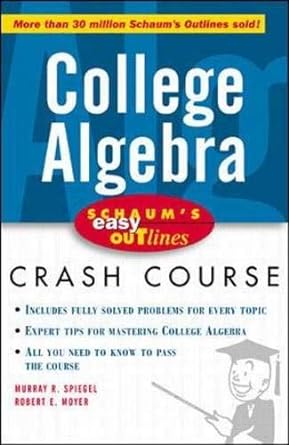Question
Question 1(3.5 points) What would be the best example of comparing and ordering fractions? (ELEM.MAT3.1.) Question 1 options: Reasoning that 3/4 is between 1/2 and
Question 1(3.5 points)
What would be the best example of comparing and ordering fractions? (ELEM.MAT3.1.)
Question 1 options:
Reasoning that 3/4 is between 1/2 and 1.
Reasoning that that 1/3 is large compared to 1/10, about the same size as 1/4, and small compared to 5/6.
Reasoning that 1/5 is larger than 1/8 since fifths are larger than eighths.
All ofthese.
Question 2(3.5 points)
Which of the following is NOT an ability students must understand in order to work effectively with fractions? (ELEM.MAT3.1)
Question 2 options:
The ability to describe the relative magnitude of numbers by comparing them to common benchmarks, giving simple estimates, ordering a set of numbers, and finding a number between two numbers.
The ability to memorize and quickly recall complicated procedures for whole number computation.
The ability to represent numbers using words, models, diagrams, and symbols and make connections among various representations.
The ability to give other names for numbers and justify the procedures used to generate the equivalent forms.
Question 3(3.5 points)
Mr. Lee wants to use an example of a measurement division problem. Which of the following would be best?(ELEM.MAT3.2)
Question 3 options:
There is 2/3 of a chocolate pie in the refrigerator. Peter ate 1/2 of it. What part of the whole pie did Peter eat?
Steve has 4 cups of sugar. He needs 2/3 of a cup of sugar to make one batch of his favorite cookies. How many batches of cookies can Steve make?
Steve has 4 cups of sugar. That is enough to bake 2/3 of batch of his favorite cookies. How much sugar will he need to make 1 batch of cookies?
Jenny had 4 bags of cookies, with 1/2 of a cookie in each bag. How many cookies did Jenny have?
Question 4(3.5 points)
If a student is using graph paper grids to demonstrate decimals, if one 10 cm by 10 cm square represents one, which of the following is correct? (ELEM.MAT3.2)
Question 4 options:
One-tenth is represented by 100 sq cm
One-hundredth is represented by one sq cm
One-tenth is represented by one sq cm
Ten is represented by 10 sq cm
Question 5(3.5 points)
How might a child use the front-end strategy to estimate the sum of 321 + 594? (ELEM.MAT3.3.)
Question 5 options:
The child would think "321 is close to 300 and 594 is close to 600 and 300 plus 600 is 900."
The child would picture the numbers in his or her head and add the ones, then the tens, then the hundreds.
The child wouldlook at the first digit in each number and think "321 + 594 is close to 300 + 500 which is 800."
Question 6(3.5 points)
When using base ten blocks to represent decimals, if the ones place is represented by a flat, which of the following is correct?(ELEM.MAT3.3.)
Question 6 options:
Ten is represented by a long.
One-hundredth is represented by a long.
One-tenth is represented by a cube.
One-tenth is represented by a long.
Question 7(3.5 points)
Which of the following is an example of an activity to help children understand equivalent fractions? (ELEM.MAT3.4.)
Question 7 options:
Using paper strips to show 3/4.
Folding paperstrips to see that 1/3 and 2/6 are the same part of the paper strip.
Using paper strips to compare 1/2 and 1/3.
Using paper strips to find the sum of 1/2 and 1/3.
Question 8(3.5 points)
Researchrecommends that teachers provide students with opportunities to practice partitioning physical objects into equal-sized parts, rather than just drawing lines on drawings of shapes. Which of the following is an example of this? (ELEM.MAT3.4.)
Question 8 options:
Shading one of four parts of a circle.
Drawing lines on a circle to show thirds.
Positioning and adjusting popsicle sticks on under a graph paper, asking students to place the image on the graph to show where the hole should be cut to make thirds, for example.
Positioning and adjusting coffee stirrers on top of a cookie, asking students to place the stirrers to show where the whole should be cut to make thirds, for example.
Question 9(3.5 points)
In the following diagram,
What is the ratio of green to yellow squares? (ELEM.MAT3.5.)
Question 9 options:
6 : 4
3 : 3
3 : 2
4 : 6
Question 10(3.5 points)
An important aspect of proportional reasoning is the ability to discriminate between proportional and non-proportional situations. Which of the following situations is a proportional situation?(ELEM.MAT3.5.)
Question 10 options:
Changing the size of the recipe.
Calculating batting averages.
Shrinking or enlarging a picture.
All are proportional situations.
Step by Step Solution
There are 3 Steps involved in it
Step: 1

Get Instant Access to Expert-Tailored Solutions
See step-by-step solutions with expert insights and AI powered tools for academic success
Step: 2

Step: 3

Ace Your Homework with AI
Get the answers you need in no time with our AI-driven, step-by-step assistance
Get Started


